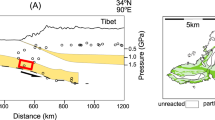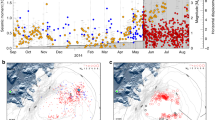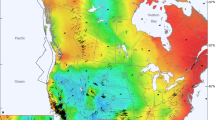Abstract
Studies of the Earth's response to large earthquakes can be viewed as large rock deformation experiments in which sudden stress changes induce viscous flow in the lower crust and upper mantle that lead to observable postseismic surface deformation1. Laboratory experiments suggest that viscous flow of deforming hot lithospheric rocks is characterized by a power law in which strain rate is proportional to stress raised to a power, n (refs 2, 3). Most geodynamic models of flow in the lower crust and upper mantle, however, resort to newtonian (linear) stress–strain rate relations4,5,6,7,8,9,10. Here we show that a power-law model of viscous flow in the mantle with n = 3.5 successfully explains the spatial and temporal evolution of transient surface deformation following the 1992 Landers11 and 1999 Hector Mine12 earthquakes in southern California. A power-law rheology implies that viscosity varies spatially with stress causing localization of strain, and varies temporally as stress evolves, rendering newtonian models untenable. Our findings are consistent with laboratory-derived flow law parameters for hot and wet olivine—the most abundant mineral in the upper mantle—and support the contention that, at least beneath the Mojave desert5,6, the upper mantle is weaker than the lower crust.
This is a preview of subscription content, access via your institution
Access options
Subscribe to this journal
Receive 51 print issues and online access
$199.00 per year
only $3.90 per issue
Buy this article
- Purchase on Springer Link
- Instant access to full article PDF
Prices may be subject to local taxes which are calculated during checkout



Similar content being viewed by others
References
Nur, A. & Mavko, G. Postseismic viscoelastic rebound. Science 183, 204–206 (1974)
Kirby, S. H. & Kronenberg, A. K. Rheology of the lithosphere; selected topics. Rev. Geophys. 25, 1219–1244 (1987)
Carter, N. L. & Tsenn, M. C. Flow properties of continental lithosphere. Tectonophysics 136, 27–63 (1987)
Thatcher, W., Matsuda, T., Kato, T. & Rundle, J. B. Lithospheric loading by the 1896 Riku-u earthquake, northern Japan; Implications for plate flexure and asthenospheric rheology. J. Geophys. Res. 85, 6429–6435 (1980)
Pollitz, F. F., Wicks, C. & Thatcher, W. Mantle flow beneath a continental strike-slip fault; postseismic deformation after the 1999 Hector Mine earthquake. Science 293, 1814–1818 (2001)
Pollitz, F. F., Peltzer, G. & Bürgmann, R. Mobility of continental mantle; Evidence from postseismic geodetic observations following the 1992 Landers earthquake. J. Geophys. Res. 105, 8035–8054 (2000)
Kenner, S. J. & Segall, P. Lower crustal structure in northern California: Implications from strain rate variations following the 1906 San Francisco earthquake. J. Geophys. Res. 108, doi:101029/2001JB000189 (2003)
Freed, A. M. & Lin, J. Delayed triggering of the 1999 Hector Mine earthquake by viscoelastic stress transfer. Nature 411, 180–183 (2001)
Freed, A. M. & Lin, J. Accelerated stress buildup on the southern San Andreas Fault and surrounding regions caused by Mojave Desert earthquakes. Geology 30, 571–574 (2002)
Deng, J., Gurnis, M., Kanamori, H. & Hauksson, E. Viscoelastic flow in the lower crust after the 1992 Landers. Science 282, 1689–1692 (1998)
Savage, J. C., Svarc, J. L. & Prescott, W. H. Near-field postseismic deformation associated with the 1992 Landers and 1999 Hector Mine, California, earthquakes. J. Geophys. Res. 108, doi:101029/2002JB002330 (2003)
Hudnut, K. W. et al. Continuous GPS observations of postseismic deformation following the 16 October 1999 Hector Mine, California, earthquake. Bull. Seismol. Soc. Am. 92, 1403–1422 (2002)
Karato, S., Paterson, M. S. & Fitzgerald, J. D. Rheology of synthetic olivine aggregates; influence of grain size and water. J. Geophys. Res. 91, 8151–8176 (1986)
Silver, P., Mainprice, D., Ismail, W. B. & Tommasi, A. Mantle Petrology: Field Observations and High Pressure Experimentation: A Tribute to Francis R. (Joe) Boyd 79–103 (Geochemical Society, Spec. Publ. No. 6, Houston, Texas, 1999)
Hirth, G., Teyssier, C. & Dunlap, W. J. An evaluation of quartzite flow laws based on comparisons between experimentally and naturally deformed rocks. Int. J. Earth Sci. 90, 77–87 (2001)
Pollitz, F. F. Transient rheology of the uppermost mantle beneath the Mojave Desert, California. Earth Planet. Sci. Lett. 215, 89–104 (2003)
Wald, D. J. & Heaton, T. H. Spatial and temporal distribution of slip for the 1992 Landers, California, earthquake. Bull. Seismol. Soc. Am. 84, 668–691 (1994)
Kaverina, A., Dreger, D. & Price, E. The combined inversion of seismic and geodetic data for the source process of the 16 October 1999 Mw 7.1 Hector Mine, California, earthquake. Bull. Seismol. Soc. Am. 92, 1266–1280 (2002)
Masterlark, T. & Wang, H. F. Transient stress-coupling between the 1992 Landers and 1999 Hector Mine, California, earthquakes. Bull. Seismol. Am. 92, 1470–1486 (2002)
Peltzer, G., Rosen, P. & Rogez, F. Poroelastic rebound along the Landers 1992 earthquake surface rupture. J. Geophys. Res. 103, 30131–30145 (1998)
Williams, C. F. Temperature and the seismic/aseismic transition; observations from the 1992 Landers earthquake. Geophys. Res. Lett. 23, 2029–2032 (1996)
Melbourne, T. & Helmberger, D. Mantle control of plate boundary deformation. Geophys. Res. Lett. 28, 4003–4006 (2001)
Goes, S. & van der Lee, S. Thermal structure of the North American uppermost mantle inferred from seismic tomography. J. Geophys. Res. 107, doi:2000JB000049 (2002)
Farmer, G. L. et al. Origin of late Cenozoic basalts at the Cima volcanic field, Mojave Desert, California. J. Geophys. Res. 100, 8399–8415 (1995)
Kronenberg, A. K. & Tullis, J. A. Flow strengths of quartz aggregates; grain size and pressure effects due to hydrolytic weakening. J. Geophys. Res. 89, 4281–4297 (1984)
Shelton, G. & Tullis, J. A. Experimental flow laws for crustal rocks. Trans. Am. Geophys. Union 62, 396 (1981)
Jaoul, O., Tullis, J. A. & Kronenberg, A. K. The effect of varying water contents on the creep behaviour of Heavitree Quartzite. J. Geophys. Res. 89, 4298–4312 (1984)
Hansen, F. D. & Carter, N. L. Creep of selected crustal rocks at 1000 MPa. Trans. Am. Geophys. Union 63, 437 (1982)
Hirth, G. & Kohlstedt, D. Rheology of the upper mantle and the mantle wedge: A view from the experimentalists. In The Subduction Factory (ed. Eiler, J.) (American Geophysical Union 2004)
Acknowledgements
Funding was provided by the National Science Foundation and the Southern California Earthquake Center. GPS data were provided by the US Geological Survey and the Southern California Integrated GPS Network..
Author information
Authors and Affiliations
Corresponding author
Ethics declarations
Competing interests
The authors declare that they have no competing financial interests.
Supplementary information
Supplementary Figure 1
Comparison of poroelastic, viscous, and combination post-Landers models. (PDF 219 kb)
Supplementary Figure 2
Comparison of poroelastic and viscous post-Hector Mine models. (PDF 256 kb)
Supplementary Figure 3
Observed and calculated GPS times series surface deformations following the Landers and Hector Mine quakes. (PDF 2031 kb)
Rights and permissions
About this article
Cite this article
Freed, A., Bürgmann, R. Evidence of power-law flow in the Mojave desert mantle. Nature 430, 548–551 (2004). https://doi.org/10.1038/nature02784
Received:
Accepted:
Issue Date:
DOI: https://doi.org/10.1038/nature02784
This article is cited by
-
Heterogeneous rheology of Japan subduction zone revealed by postseismic deformation of the 2011 Tohoku-oki earthquake
Progress in Earth and Planetary Science (2023)
-
Physics-informed deep learning approach for modeling crustal deformation
Nature Communications (2022)
-
MCMC inversion of the transient and steady-state creep flow law parameters of dunite under dry and wet conditions
Earth, Planets and Space (2021)
-
Probing time-dependent afterslip and viscoelastic relaxation following the 2015 Mw7.8 Gorkha earthquake based on the 3-D finite-element model
Earth, Planets and Space (2020)
-
Structural control and system-level behavior of the seismic cycle at the Nankai Trough
Earth, Planets and Space (2020)
Comments
By submitting a comment you agree to abide by our Terms and Community Guidelines. If you find something abusive or that does not comply with our terms or guidelines please flag it as inappropriate.



